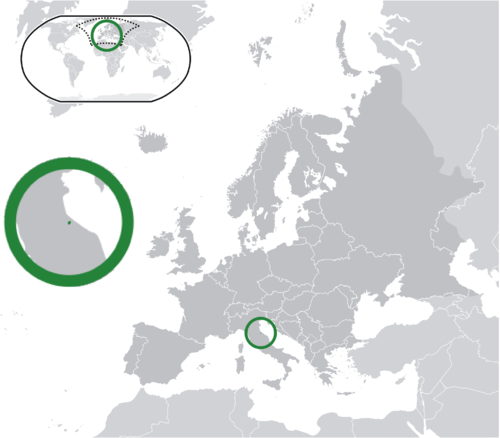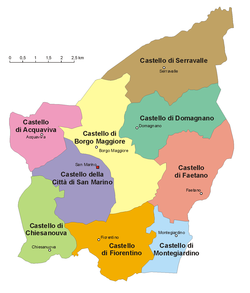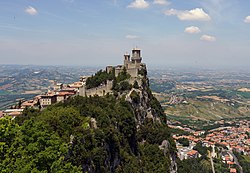San Marino
San Marino (officially called the Most Serene Republic of San Marino) is a country in Europe. It is one of the smallest countries in the world. It is in Southern Europe and is fully surrounded by Italy (this is called an enclave, and only the Vatican City, Lesotho and San Marino are like this). Fewer than 30,000 people live there. Its total area is 61 km2. Its capital is the City of San Marino.
Republic of San Marino[1] Repubblica di San Marino (Italian) | |
|---|---|
| Motto: | |
| Anthem: | |
 Location of San Marino (green) on the European continent (agate grey) — [Legend] | |
| Capital | City of San Marino 43°56′N 12°26′E / 43.933°N 12.433°E |
| Official languages | Italian[2] |
| Religion | 97% Roman Catholicism 3% Other |
| Demonym(s) | Sammarinese |
| Government | Unitary assembly-independent diarchic directorial republic |
| Matteo Rossi Lorenzo Bugli | |
| Luca Beccari | |
| Legislature | Grand and General Council |
| Independence | |
• from Roman Empire | September 3, 301 A.D.[1] |
| October 8, 1600 (statutes) | |
| Area | |
• Total | 61.2 km2 (23.6 sq mi)[1] (190th) |
• Water (%) | 0 |
| Population | |
• 2020 estimate | 34,232[1] (221st) |
• Density | 520/km2 (1,346.8/sq mi) (23rd) |
| GDP (PPP) | 2017 estimate |
• Total | $2.09 billion[3] (175th) |
• Per capita | $60,651[3] (11th) |
| GDP (nominal) | 2017 estimate |
• Total | $1.55 billion[3] (174th) |
• Per capita | $44,947[3] (13th) |
| HDI (2013) | 0.875[4] very high · 26th |
| Currency | Euro (€) (EUR) |
| Time zone | UTC+01 (CET) |
• Summer (DST) | UTC+02 (CEST) |
| Driving side | right |
| Calling code | +378 (+39 0549 calling via Italy) |
| ISO 3166 code | SM |
| Internet TLD | .sm |
San Marino is claimed to be the world's oldest republic that still exists. It was started on September 3, 301 A.D. by a skilled builder called Saint Marinus. Its written constitution was adopted on October 8, 1600. The very small nation was recognized by Napoleon's France in 1797, and by the other European nations at the 1815 Congress of Vienna.
Even though it is an independent country, it depends very much on Italy. Since the 19th century, when Italy was unified, San Marino has been fully surrounded by Italy.
The biggest industry in San Marino is tourism. Selling postage stamps is an important source of income, too. San Marino is not a member of the European Union, but the euro is used in San Marino.
People in San Marino speak the Italian language. Most people in San Marino believe in Roman Catholicism.
History
Saint Marinus left the island of Rab (today Croatia) with his lifelong friend Leo, and went to the city of Rimini to work as a stonemason. After the Persecution of Diocletianus following his Christian sermons, he escaped to the nearby Monte Titano. There he built a small church and founded what is now the city and state of San Marino.
The official founding date is 3 September 301 AD.[6] In 1320 the community of Chiesanuova chose to join the country. In 1463 San Marino extended with the communities of Faetano, Fiorentino, Montegiardino, and Serravalle. Since then there have been no changes in the country's borders.
In 1503, Cesare Borgia occupied the Republic for six months. It remained like that until Pope Julius II intervened and restored the country's independence.
Geography
 View of a place called Borgo Maggiore |
San Marino is covered by the Apennine mountain range, and it has a rugged terrain with no natural level ground. The highest point in the country is Monte Titano. There are no bodies of water of any significant size. It is between the Italian regions of Emilia-Romagna and Marche.
San Marino is the third smallest country in Europe, Only Vatican City and Monaco are smaller.
Two rivers flow through San Marino. There is no major water transport, and no major port or harbour.
Municipalities
These are the 9 castelli (municipalities) of San Marino:
| Cities in San Marino | |||||
| Rank | City | Area km2 |
Population | ||
| 1986 | 1996 | 2006 | |||
| 1. | Serravalle | 10.53 | 6,995 | 8,085 | 9,847 |
| 2. | Borgo Maggiore | 9.01 | 4,421 | 5,358 | 6,061 |
| 3. | City of San Marino | 7.09 | 4,179 | 4,350 | 4,409 |
| 4. | Domagnano | 6.62 | 1,885 | 2,207 | 2,899 |
| 5. | Fiorentino | 6.56 | 1,478 | 1,798 | 2,253 |
| 6. | Acquaviva | 4.86 | 1,148 | 1,264 | 1,881 |
| 7. | Faetano | 7.75 | 738 | 870 | 1,139 |
| 8. | Chiesanuova | 5.46 | 724 | 866 | 1036 |
| 9. | Montegiardino | 3.31 | 557 | 717 | 843 |
| San Marino | 61.19 | 22,125 | 25,515 | 30,368 | |
Food
The food of San Marino is very similar to Italian, especially the Emilia-Romagna and Marche regions. It has a lots of its own unique foods. It's best known food is the Torta Tre Monti ("Cake of the Three Mountains" or "Cake of the Three Towers"), a wafer cake covered in chocolate. The country also has a small wine industry.
Public holidays and festivals
| Date | Name | Explanation |
|---|---|---|
| 1 January | New Year's Day | Festival marking the beginning of the new year. |
| 6 January | Epiphany | Commemorates the visit of the three Wise Men or magi to the infant Jesus. |
| 5 February | Feast of Saint Agatha | Commemoration of St. Agatha, Patroness of the Republic, as well as liberation from foreign rule. |
| variable * | Easter | Resurrection of Jesus. |
| variable ** | Easter Monday | Monday after Easter day. |
| 25 March | Anniversary of the Arengo | Anniversary of the Arengo and the Festa delle Milizie (Feast of the Militants). |
| 1 May | Labour Day | Celebration of workers and employees. |
| variable *** | Corpus Domini | Commemoration of the body and blood of Jesus Christ. |
| 28 July | Liberation from Fascism | Commemoration of the fall of the Sammarinese Fascist Party. |
| 15 August | Ferragosto (Assumption) | Commemoration of the Virgin Mary's direct assumption into heaven upon her death. |
| 3 September | The Feast of San Marino and the Republic | National feast of San Marino, celebrating the origin of the Republic in 301. |
| 1 November | All Saints' Day | Feast dedicated to all saints. |
| 2 November | Commemoration of all those who died at war | Remembrance of all those who gave their lives for San Marino in war. |
| 8 December | Immaculate Conception | Remembrance of the Virgin Mary's conception without original sin. |
| 24 December | Christmas Eve | Day before the commemoration of the birth of Jesus. |
| 25 December | Christmas | Birth of Jesus. |
| 26 December | St. Stephen's Day | Commemoration of the death of Saint Stephen, the first Christian martyr. |
| 31 December | New Year's Eve | Celebration which closes and marks the end of the year. |
| * Easter: the first Sunday after the full moon and the March equinox ** Easter Monday: the Monday after Easter day *** Corpus Domini: the first Thursday after Trinity Sunday | ||
San Marino Media
Inno Nazionale della Repubblica
The fortress of Guaita on Monte Titano, a UNESCO recognized World Heritage Site.
This map of San Marino shows the country's cities, towns, villages and some other geographical details, and is likely the most comprehensive map of the country in this respect that you'll find anywhere online. It has been stitched together from panels of Open Street Map (which is freely licensed to all) with details plotted by the uploader.
The Palazzo Pubblico, seat of the government of San Marino
Four former captains regent: from left to right, Mirko Tomassoni, Alessandro Rossi, Alessandro Mancini, and Alberto Selva
References
- ↑ 1.0 1.1 1.2 1.3 1.4 CIA World Factbook information about San Marino
- ↑ "San Marino è". GOV.SM. Repubblica di San Marino. Archived from the original on 7 May 2021. Retrieved 28 August 2020.
- ↑ 3.0 3.1 3.2 3.3 San Marino. Imf.org.
- ↑ Filling Gaps in the Human Development Index Archived 5 October 2011 at the Wayback Machine, United Nations ESCAP, February 2009
- ↑ "San Marino" (PDF). UNECE Statistics Programme. UNECE. 2009. Retrieved 13 March 2010.
- ↑ "San Marino country profile" (in en-GB). BBC News. 2018-05-18. https://www.bbc.com/news/world-europe-17842338. Retrieved 2022-03-07.









